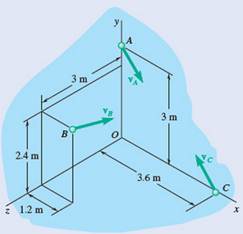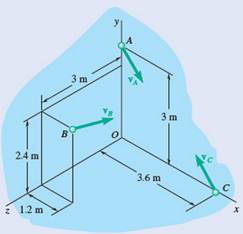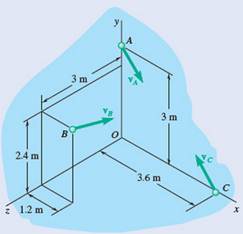
Concept explainers
For the system of particles of Prob. 14.13, determine (a) the position
(a)
The position vector of the mass centre, G of the system.
Answer to Problem 14.14P
Explanation of Solution
Given information:

Mass of A
Mass of B
Mass of C
Velocity of A
Velocity of B
Velocity of C
We can find the position vectors at centre O with the help of figure at points A, B and C.
Position vector at A,
Position vector at B,
Position vector at C,
The position vector at mass centre G is,
Conclusion:
The position vector of the given system is,
(b)
The linear momentum of the system.
Answer to Problem 14.14P
Explanation of Solution
Given information:

Mass of A
Mass of B
Mass of C
Velocity of A
Velocity of B
Velocity of C
The linear momentum of each particle,
Linear momentum of particle A,
Linear momentum of particle B,
Linear momentum of particle C,
Now, total linear momentum of the system,
Conclusion:
Linear moment of the system,
(c)
The angular momentum of system about point ‘G’. And also to show that the answer is verify the equation
Answer to Problem 14.14P
Explanation of Solution
Given information:

Mass of A
Mass of B
Mass of C
Velocity of A
Velocity of B
Velocity of C
We can find the position vectors at centre O with the help of figure at points A, B and C.
Position vector at A,
Position vector at B,
Position vector at C,
The position vector at mass centre G is,
Position vector relative to the mass centre,
Now, angular momentum about G,
Now, we show that this answer is verified the given formula:
Now, the angular momentum about G is added in the above obtained equation:
Now, Angular moment of all the particles about point O,
Hence the above obtained values verify the equation:
Want to see more full solutions like this?
Chapter 14 Solutions
Vector Mechanics For Engineers
- Conservation of Linear Momentum for a System of Particles Two spheres A and B (of mass m each) were fired vertically from the ground with different initial velocities at different times. When sphere A reached its summit, sphere B, with an upward velocity of 17 m/s, created a head on collision with A. The impact caused sphere A to break into two pieces, each of mass m/2. Knowing one piece reached Point C and the other piece reached point D after the collision, determine (a) the velocity of sphere B after the collision; (b) the angle and the speeds of the two pieces after the collision; and (c) the force exerted by sphere A on B if the collision occurred in 0.001 s.arrow_forwardTwo identical spheres A and B each of mass m , are attached to an inextensible inelastic cord of length L and are resting at a distance a from each other on a frictionless horizontal surface. Sphere B is given a velocity v0 in a direction perpendicular to line AB and moves it without friction until it reaches B ’ where the cord becomes taut. Draw the impulse-momentum diagram that can be used to determine the magnitude of the velocity of each sphere immediately after the cord has become taut.arrow_forwardTwo spheres, each of mass m, can slide freely on a frictionless, horizontal surface. Sphere A is moving at a speed v0 = 16 ft/s when it strikes sphere B which is at rest, and the impact causes sphere B to break into two pieces, each of mass m/2.a) Knowing that 0.7 s after the collision one piece reaches Point C and 1.17 s after the collision the other piece reaches Point D, determine the velocity of sphere A after the collision.b) Knowing that 0.7 s after the collision one piece reaches Point C and 1.17 s after the collision the other piece reaches Point D, determine the angle θ and the speeds of the two pieces after the collision.arrow_forward
- Considering a glancing collision between a cue ball of mass m moving at initial velocity u and a target ball of the same mass initially at rest. This results in a two-dimensional collision with the cue ball's final velocity v making an angle θ with the target ball's final velocity w. Show explicitly that the collision is elastic if and only if θ = π/2 = 90°.arrow_forwardA particle of momentum P1 collides with a particle at rest. After the collision, the particle initially at rest decays into two particles of momentum P3 and P4, respectively, while particle 1 continues in a straight line with momentum P1'. Knowing the magnitudes of all the momentum listed above and knowing that energy was not conserved during the process, find the angle θ (theta) between particles 3 and 4.arrow_forwardA sphered, of mass 2m, moving speed 2u on a smooth horizontal plane, collides directly with another sphere B of radius and of mass m which is moving with speed u in the opposite direction. Given that the coefficient of restitution between the spheres is ½ , findTheir speeds after the collision,The magnitude of the instantaneous impulse,The loss in kinetic energy caused by the collision,After a short interval, the sphere A is given a horizontal impulse of magnitude 7mu so that it collides again directly with sphere B. Find the speed of A and the speed of B after second impact.arrow_forward
- A cyclist is riding a bicycle at a speed of 20 mph on a horizontal road. The distance between the axles is 42 in., and the mass center of the cyclist and the bicycle is located 26 in. behind the front axle and 40 in. above the ground. If the cyclist applies the brakes only on the front wheel, determine the shortest distance in which he can stop without being thrown over the front wheel.arrow_forwardA piece of mass M is hung by a string of length L . A ball of mass m = M / 4 has a velocity V• when it hits the piece and sinks into it. As soon as the progress of the bullet in the piece stops completely, the string tension is 2.5Mg. What is the velocity V•?arrow_forwardTwo small balls A and B with masses 2m and m , respectively, are released from rest at a height h above the ground. Neglecting air resistance, which of the following statements is true when the two balls hit the ground? a. The kinetic energy of is the same as the kinetic energy of B.b. The kinetic energy of A is half the kinetic energy of B.c. The kinetic energy of A is twice the kinetic energy of B.d. The kinetic energy of A is four times the kinetic energy of B.arrow_forward
- A system consists of three identical 5-kg particles A, B, and C. Their position vectors (in meter) and velocity vectors (in m/s) are rA 0,0, 3 , v A v Aj , rB 2,2, 3 , vB v B i , and rC 1,4, 0 , vC v C k, respectively. Knowing that the angular momentum of the system about point O is HO 1.5k kg m 2s, determine (a) the velocities of the particles, (b) the angular momentum of the system about its center of mass G.arrow_forwardA billiard player sends the cue ball toward a group of three balls that are initially at rest and in contact with one another. After the cue ball strikes the group, the four balls scatter, each traveling in a different direction with different speeds as shown in the figure below. If each ball has the same mass, 0.16 kg, determine the total momentum of the system consisting of the four balls immediately after the collision. (Assume v1 = 0.33 m/s, θ1 = 70°, v2 = 0.49 m/s, θ2 = 30°, v3 = 0.21 m/s, v4 = 0.48 m/s.) magnitude ? (in kg m/s^2) direction ? (in degrees counterclockwise from the + x-axis)arrow_forwardA rocket weighs 2600 lb, including 2200 lb of fuel, which is consumed at the rate of 25 lb/s and ejected with a relative velocity of 13,000 ft/s. Knowing that the rocket is fired vertically from the ground, determine (a) its acceleration as it is fired, (b) its acceleration as the last particle of fuel is being consumed, (c) the altitude at which all the fuel has been consumed, (d) the velocity of the rocket at that time.arrow_forward
 Elements Of ElectromagneticsMechanical EngineeringISBN:9780190698614Author:Sadiku, Matthew N. O.Publisher:Oxford University Press
Elements Of ElectromagneticsMechanical EngineeringISBN:9780190698614Author:Sadiku, Matthew N. O.Publisher:Oxford University Press Mechanics of Materials (10th Edition)Mechanical EngineeringISBN:9780134319650Author:Russell C. HibbelerPublisher:PEARSON
Mechanics of Materials (10th Edition)Mechanical EngineeringISBN:9780134319650Author:Russell C. HibbelerPublisher:PEARSON Thermodynamics: An Engineering ApproachMechanical EngineeringISBN:9781259822674Author:Yunus A. Cengel Dr., Michael A. BolesPublisher:McGraw-Hill Education
Thermodynamics: An Engineering ApproachMechanical EngineeringISBN:9781259822674Author:Yunus A. Cengel Dr., Michael A. BolesPublisher:McGraw-Hill Education Control Systems EngineeringMechanical EngineeringISBN:9781118170519Author:Norman S. NisePublisher:WILEY
Control Systems EngineeringMechanical EngineeringISBN:9781118170519Author:Norman S. NisePublisher:WILEY Mechanics of Materials (MindTap Course List)Mechanical EngineeringISBN:9781337093347Author:Barry J. Goodno, James M. GerePublisher:Cengage Learning
Mechanics of Materials (MindTap Course List)Mechanical EngineeringISBN:9781337093347Author:Barry J. Goodno, James M. GerePublisher:Cengage Learning Engineering Mechanics: StaticsMechanical EngineeringISBN:9781118807330Author:James L. Meriam, L. G. Kraige, J. N. BoltonPublisher:WILEY
Engineering Mechanics: StaticsMechanical EngineeringISBN:9781118807330Author:James L. Meriam, L. G. Kraige, J. N. BoltonPublisher:WILEY





